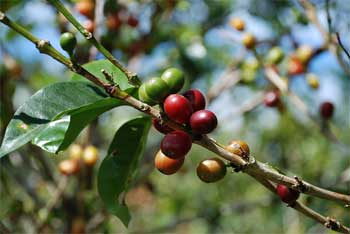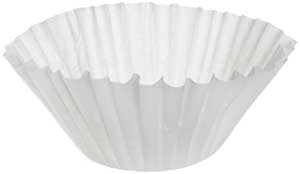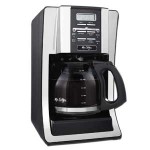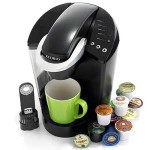How Humans Discovered Coffee
 As with many foods which have been around for hundreds of years, the beginning of coffee is wrapped in mystery and myth. There was a known Ethiopian legend when Kaldi, a goat-herder, noticed some energizing effects when his flock was eating the red berries of a particular bush or tree, he then chewed some of the fruit for himself. The goat-herder dutifully reported and brought some of the berries to a monk in his local monastery. However the monk did not approve of their use, and the monk threw the berries into a fire, from which an alluring aroma billowed forth, causing other monks to go and investigate. Roasted beans were then raked in the embers, grinded and then dissolved with hot water, producing the first cup of coffee in the world. Then knowledge of the energizing effects of these berries spread and as word moved to the east until coffee reached the Arabian Peninsula where it began its journey, spreading its reputation across the world.
As with many foods which have been around for hundreds of years, the beginning of coffee is wrapped in mystery and myth. There was a known Ethiopian legend when Kaldi, a goat-herder, noticed some energizing effects when his flock was eating the red berries of a particular bush or tree, he then chewed some of the fruit for himself. The goat-herder dutifully reported and brought some of the berries to a monk in his local monastery. However the monk did not approve of their use, and the monk threw the berries into a fire, from which an alluring aroma billowed forth, causing other monks to go and investigate. Roasted beans were then raked in the embers, grinded and then dissolved with hot water, producing the first cup of coffee in the world. Then knowledge of the energizing effects of these berries spread and as word moved to the east until coffee reached the Arabian Peninsula where it began its journey, spreading its reputation across the world.
Today coffee is cultivated in many countries around the globe. Whether in Asia, Austria or Africa, South or Central America, and the Pacific or islands of the Caribbean, all will trace the heritage to the plants in ancient forests in the Ethiopian plateau.
It was in the 13th century when people started roasting the coffee beans, the 1st step of the process when making coffee as we knew today.

Share this Image On Your Site
The invention of coffee filters
 A coffee filter which is a brewing utensil is mostly made of disposable paper filters. It is used to trap coffee grounds and allow liquid coffee to run through.
A coffee filter which is a brewing utensil is mostly made of disposable paper filters. It is used to trap coffee grounds and allow liquid coffee to run through.
A German housewife, Melitta Bentz invented the first coffee paper filter on July 08, 1908. She really wanted to effectively eliminate the bitter taste caused by boiling loose coffee grounds or when using the common method of linen in brewing coffee. She experimented with different means, yet ended up by using blotting papers from her son’s exercise book. When the coffee grounds free, less bitter coffee met with enthusiasm, she then decided to start a business. Melitta Bentz patented her invention and organized a company that sells coffee filters. She hired her husband and 2 sons who became it’s first employees.
How popular is coffee
Other than oil, coffee would be likely the most precious legal commodity on earth. People around the world would roughly consume 2 billion cups each day. For every 3 people, one cup is consumed each day and this is an incredible ratio. No wonder why there is such a huge market for coffee machines. It was in 1990s when people first demanded more appealing appliances that can complement modern kitchens, and this resulted in a new trend of redesigned coffee machines available in a wider range of colors and styles to choose from.
History and description of the different types of coffee machines
Coffee machines help make life so easy that we just cannot afford not to use them when brewing coffee. The convenience factor and caffeine boost, along with the busy schedules, prevent more people from manual brewing. There are even coffee makers that are able to brew a cup or pot of coffee while you take your morning shower. Just imagine what our ancestors had to go through to make coffee. Here are the types of coffee makers that are mostly being used of today.
 Drip Coffee Maker – This type of coffee maker debuted in America in 1972 as the popular Mr. CoffeeTM and was an instant success that popularized the automatic drip brew method. In 1996, around 73 percent of American households reported using an automatic drip coffeemaker. With automatic drip coffee machines, a measured volume of cold water is poured over into a separate chamber where a heating component heats water to near boiling. Hot water is distributed over the coffee grounds in a metal or paper filter, through a device such as the shower head. Then water seeps through the grounds, absorbing its essences and oils, and passes through to the bottom of the coffee filter. Coffee grounds are kept in the coffee filter while the coffee liquid drips into a coffee pot. You can choose a drip coffee maker in a 4-12 cups capacity and in different styles, colors, models and prices.
Drip Coffee Maker – This type of coffee maker debuted in America in 1972 as the popular Mr. CoffeeTM and was an instant success that popularized the automatic drip brew method. In 1996, around 73 percent of American households reported using an automatic drip coffeemaker. With automatic drip coffee machines, a measured volume of cold water is poured over into a separate chamber where a heating component heats water to near boiling. Hot water is distributed over the coffee grounds in a metal or paper filter, through a device such as the shower head. Then water seeps through the grounds, absorbing its essences and oils, and passes through to the bottom of the coffee filter. Coffee grounds are kept in the coffee filter while the coffee liquid drips into a coffee pot. You can choose a drip coffee maker in a 4-12 cups capacity and in different styles, colors, models and prices.
 Single-serve Coffee Maker – This type of coffee maker has gained its popularity in recent years. It is a coffee brewing method that prepares only exact or enough coffee for a single portion. Its brewing system lets a measured amount of heated water to go through the coffee pack or pod, producing a standardized cup of brewed coffee into a container positioned under the outlet. Coffee pods are pre-packed ground coffee in their own filter. You can choose a wide range of beverages available for brewing using single-serve coffee makers such as hot chocolate, tea and other milk based specialty beverages. Single-serve coffeemakers are great for clean and quick serving of specialty coffees.
Single-serve Coffee Maker – This type of coffee maker has gained its popularity in recent years. It is a coffee brewing method that prepares only exact or enough coffee for a single portion. Its brewing system lets a measured amount of heated water to go through the coffee pack or pod, producing a standardized cup of brewed coffee into a container positioned under the outlet. Coffee pods are pre-packed ground coffee in their own filter. You can choose a wide range of beverages available for brewing using single-serve coffee makers such as hot chocolate, tea and other milk based specialty beverages. Single-serve coffeemakers are great for clean and quick serving of specialty coffees.
 Percolator – It was in 1865 when James Nason who lived in Massachusetts patented a percolator design. Then Hanson Goorich, a farmer in Illinois was generally accredited with patenting modern percolators and it was on August 16, 1889 that his patent was granted. Goodrich’s patent description differs little with the stovetop percolators of today. The percolator design works by heating water in a boiling pot with a detachable lid, heated water is pushed through in a metal tube and into the brew basket that contains the coffee. Extracted liquids drain from brew basket and drip back into the coffee pot. The procedure is continuously repeated in the brewing cycle up to the point when liquid flowing repeatedly through the coffee grounds has already sufficiently steeped. The user will judge when coffee has already reached the right color and strength by looking through the transparent knob on its lid. Then electrification came and simplified the percolator’s operation by featuring a self contained, heating element powered by electricity which eliminated the need for a stovetop burner. While earlier percolator design used glass construction, percolators that are made from 1930s and above were constructed of metal, mostly with aluminum & copper.
Percolator – It was in 1865 when James Nason who lived in Massachusetts patented a percolator design. Then Hanson Goorich, a farmer in Illinois was generally accredited with patenting modern percolators and it was on August 16, 1889 that his patent was granted. Goodrich’s patent description differs little with the stovetop percolators of today. The percolator design works by heating water in a boiling pot with a detachable lid, heated water is pushed through in a metal tube and into the brew basket that contains the coffee. Extracted liquids drain from brew basket and drip back into the coffee pot. The procedure is continuously repeated in the brewing cycle up to the point when liquid flowing repeatedly through the coffee grounds has already sufficiently steeped. The user will judge when coffee has already reached the right color and strength by looking through the transparent knob on its lid. Then electrification came and simplified the percolator’s operation by featuring a self contained, heating element powered by electricity which eliminated the need for a stovetop burner. While earlier percolator design used glass construction, percolators that are made from 1930s and above were constructed of metal, mostly with aluminum & copper.
 French Press – This type of coffeemaker requires that the coffee should be a coarser grind compared to drip brew coffee filter. Finer coffee grounds will only seep through the press, then into the brewed coffee. The brewing method of a French press works by placing coffee and water altogether, stirring it and leaving it to brew for few minutes, and then by pressing the plunger, trapping the grounds in the bottom of its beaker. Coffee purists praised the great qualities of a French press, claiming that it makes the finest coffee flavor.
French Press – This type of coffeemaker requires that the coffee should be a coarser grind compared to drip brew coffee filter. Finer coffee grounds will only seep through the press, then into the brewed coffee. The brewing method of a French press works by placing coffee and water altogether, stirring it and leaving it to brew for few minutes, and then by pressing the plunger, trapping the grounds in the bottom of its beaker. Coffee purists praised the great qualities of a French press, claiming that it makes the finest coffee flavor.
 Espresso Machines – The first espresso machine was patented and built by Angelo Moriondo from Turin, Italy. In 1884 when he demonstrated a sample of this machine at the General Exposition in Turin, then his patent was granted on May 16, 1884. A certificate was awarded to him for the invention titled “New steam machine for economic & instantaneous confection of coffee beverage”. Luifi Bezzera from Milan, a mechanic, patented many improvements to this machine in 1901. It was named “The Innovations in machinery to prepare & immediately serve coffee beverage”, granted on June 1902. Then in 1905 when the patent was bought by Pavoni Desiderio , founder of the company “La Pavoni”, started to produce the machines commercially in a workshop in Milan, one espresso machine per day. Today, there are many drive mechanisms used in different machine designs to create espresso: Steam, Piston, Pump and Air driven, but they share some common elements: grouphead and portafilter. Espresso machines may also feature a steaming wand that steams and froths milk for cappuccino or latte. An espresso machine works by forcing the pressurized water in near boiling to go through a puck of coffee grounds and a filter to produce a highly concentrated coffee known as espresso.
Espresso Machines – The first espresso machine was patented and built by Angelo Moriondo from Turin, Italy. In 1884 when he demonstrated a sample of this machine at the General Exposition in Turin, then his patent was granted on May 16, 1884. A certificate was awarded to him for the invention titled “New steam machine for economic & instantaneous confection of coffee beverage”. Luifi Bezzera from Milan, a mechanic, patented many improvements to this machine in 1901. It was named “The Innovations in machinery to prepare & immediately serve coffee beverage”, granted on June 1902. Then in 1905 when the patent was bought by Pavoni Desiderio , founder of the company “La Pavoni”, started to produce the machines commercially in a workshop in Milan, one espresso machine per day. Today, there are many drive mechanisms used in different machine designs to create espresso: Steam, Piston, Pump and Air driven, but they share some common elements: grouphead and portafilter. Espresso machines may also feature a steaming wand that steams and froths milk for cappuccino or latte. An espresso machine works by forcing the pressurized water in near boiling to go through a puck of coffee grounds and a filter to produce a highly concentrated coffee known as espresso.
Post entry: BLOG